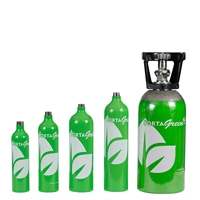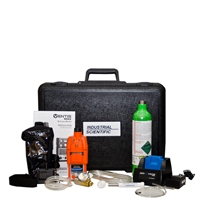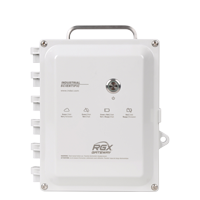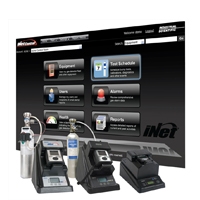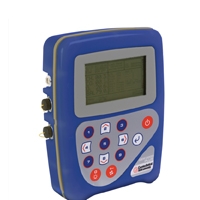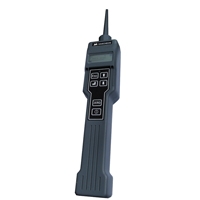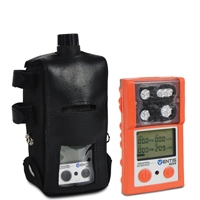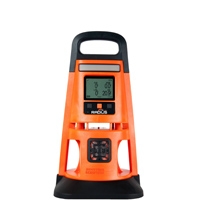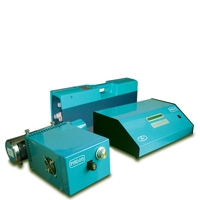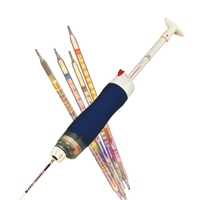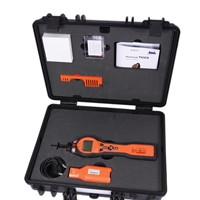Portable Gas Detection
Portable Gas Detection
Used in a variety of industries from mining to waste management, portable gas detectors are classed as a type of Personal Protective Equipment (PPE) as they are designed to protect and alert personnel to hazardous gases in the area by displaying real-time gas levels for a variety of toxic, combustible, flammable gases and volatile organic compounds (VOCs).
Benefits of Portable Gas Detectors
Air-Met Scientific offers a comprehensive range of personal gas detection equipment for both sale and rental that are lightweight and ergonomic, allowing them to be highly portable and unobtrusive. These instruments are easily attached to the body or held in the hand and can be conveniently and securely transported in a rugged travel case. Personal portable gas detectors are particularly useful for applications that require continuous monitoring within the user’s breathing zone. In addition to personal gas detectors, Air-Met Scientific also provides a selection of portable area gas monitors, photoionisation detectors (PIDs), leak detectors and more. These devices are designed for easy transportation and flexible setup, allowing for targeted monitoring of various types of gases.
For added convenience, Air-Met Scientific provides service and calibration by a team of experienced technicians to ensure your gas detectors are well-maintained and functioning optimally to protect worker safety.
Overview of the Industrial Scientific iNet Platform
Portable gas detection is instrumental in providing protection to workers potentially exposed to gas-related hazards. Monitoring is straight-forward when only a few detectors are necessary, but on medium and larger sites, the implementation of gas detection systems and programs can be highly complex and challenging to administer. Industrial Scientific’s iNet Safety Platform provides an integrated solution for streamlined management of gas detection systems, providing businesses with a powerful connected gas detection program that provides real-time analytics, safety notifications and more.
Users can customise their iNet experience with the three offerings available:
- iNet Control+ provides unparalleled visibility into a gas detection program by allowing hazards, workers and equipment to all be managed on a single simple dashboard.
- iNet Now is a live monitoring software that provides real-time alerts for gas hazards, panic and man down alarms for efficient and effective incident response as well as the capacity to verify worker status and location.
- iNet Exchange reviews the performance of equipment, notifies the user whether the monitor needs to be replaced soon and automatically sends a replacement gas monitor to site, eliminating downtime as equipment maintenance or repairs are conducted.
Streamlined, efficient management of gas detection systems minimises downtime and ensures workers are protected, creating a productive and safe workplace.
Types of Portable Gas Detectors and Leak Detectors
Ideal for confined space monitoring, spot leak testing, perimeter gas monitoring, Air-Met Scientific offers a range of gas monitoring instruments, calibration gases and accessories required to protect your workers on-site from hazardous gases.
Our comprehensive product range includes:
- Single-Gas Detectors: cost-effective, easy to use, lightweight monitors designed to detect a specific gas.
- Multi-Gas Monitors: available in a range of gas configurations, our multi-gas monitors can detect a range of toxic, flammable, and combustible gases, providing real-time visibility into the status and safety of the area. Multi-gas monitors can simultaneously detect numerous gases across a range of industrial settings, eliminating the need for multiple devices as it offers a variety of sensor configuration options.
- Gas Detector Docking Stations: automated systems designed to charge and maintain a gas detector as well as provide a record-keeping solution.
- Gas Detection Management Software: a fleet management software that provides unparalleled visibility into your gas detection program remotely with one simple dashboard.
- Photoionisation Detectors (PIDs): most commonly used for on-site detection of volatile organic compounds (VOCs) at the parts-per-million (ppm) level.
- Landfill Gas Analysers: engineered for the monitoring and analysing of a range of harmful gases such as methane, carbon dioxide, hydrogen sulphide and more in contaminated land sites and landfills.
- Gas Leak Detectors: designed for the detection and pinpoint localisation of gas leaks such as helium and SF6.
- Portable Area Gas Monitors: Available for sale or rental, Air-Met’s range of portable area gas monitors are ideal for use in perimeter monitoring, fence line monitoring and more.
- Portable Mercury Analysers: Exposure to mercury, even in small amounts can lead to a range of health problems including nausea, shortness of breath, vomiting and more. Our range of mercury analysers can assist in rapid and accurate detection of mercury vapour in ambient air.
- Gas Detection Tubes: a cost-effective and easy to use method of testing for a variety of gases. Detector tubes measure the concentration of specific gases present in the air and in most cases the concentrate can be read directly off the measurement scale on each tube.
At Air-Met Scientific, we offer a complete and comprehensive range of gas detection solutions for both sale and rental. We also supply calibration gases and accessories to meet your gas detection program requirements. Contact one of our seven locations across Australia to discuss your needs with our experienced team.
Portable Gas Detection Frequently Asked Questions
Here are some FAQs on portable gas detectors. Can’t find the answers here? Get in touch with your local Air-Met Scientific office and our team will be happy to help.
Yes, Air-Met Scientific offers a range of portable gas detection equipment for short and long-term hire, including single-gas and multi-gas detectors, with a variety of sensors to detect different gases. Interested in renting a gas detector? Contact your local Air-Met Scientific Rental office to discuss your monitoring requirements. Air-Met Scientific have rental offices in most major cities including Melbourne, Sydney, Brisbane, Mackay, Perth and Adelaide.
Yes, Air-Met Scientific provides confined space gas detection kit rentals for use in a variety of applications. These kits typically include a multi-gas detector such as the Industrial Scientific Ventis MX4 with sensors for measuring the concentration of several gases, including oxygen, carbon monoxide, hydrogen sulphide, and flammable gases. Contact your local Air-Met Rental office to learn more.
Yes, Air-Met Scientific provides service and calibration for a wide range of gas detectors and other environmental and occupational monitoring equipment. They have service centres located in major cities throughout Australia, and their team of qualified technicians is trained to service, repair, and calibrate gas detectors to ensure that they are functioning correctly and providing accurate readings. On-site service support is also available for gas monitors and can be particularly beneficial for industries where equipment downtime can be costly or where regular monitoring is required. Contact your local service team to book an on-site visit.
LEL stands for Lower Explosive Limit in gas detection. The Lower Explosive Limit is the lowest concentration of a gas or vapour that can ignite or explode in the presence of an ignition source. The LEL is expressed as a percentage of the gas or vapour in air. For example, the LEL of methane is 5%, which means that if the concentration of methane in the air is below 5%, it is not flammable, but if it exceeds 5%, it can ignite if there is a source of ignition such as a spark or flame.
LEL is an important parameter to monitor in industrial settings where flammable gases or vapours may be present, such as in petrochemical plants, refineries, and natural gas processing facilities. Gas detectors that measure LEL are designed to provide an early warning of potentially hazardous conditions, allowing workers to take appropriate safety measures, such as shutting down equipment or evacuating the area.
A portable gas monitor can be used to monitor the concentration of a wide range of gases, depending on the sensors installed in the device. Some common gases that can be monitored using a portable gas monitor include:
- Oxygen (O2): Portable gas monitors can detect the level of oxygen in the air to ensure that workers are operating in a safe environment. Low levels of oxygen can be a sign of an oxygen-deficient environment or an enclosed space that is not well-ventilated.
- Carbon monoxide (CO): CO is a toxic gas that is produced by the incomplete combustion of fuels such as gas, oil, and wood. Portable gas monitors can detect CO in the air, which is essential to protect workers in industrial settings, and other indoor environments.
- Hydrogen sulphide (H2S): H2S is a highly toxic gas that is commonly found in natural gas and petroleum products. Portable gas monitors can detect H2S in the air, which is essential for workers in the oil and gas industry, wastewater treatment plants, and other industries where H2S can be present.
- Flammable gases: Portable gas monitors can detect the presence of flammable gases, including methane, propane, and butane, which can be a fire and explosion hazard in certain industrial settings.
- Volatile Organic Compounds (VOCs): Portable gas monitors can detect VOCs, which are organic chemicals that can be released into the air from certain products or processes. VOCs can have both short- and long-term health effects and can also contribute to air pollution.
Other gases that can be monitored using a portable gas monitor include nitrogen dioxide (NO2), sulphur dioxide (SO2), chlorine (Cl2), and ammonia (NH3), among others.
A portable 4 gas monitor is a device designed to detect the presence of four common gases in the environment. The standard configuration for a portable 4 gas monitor typically includes sensors for measuring the concentration of:
- Oxygen (O2)
- Flammable gases (LEL)
- Carbon monoxide (CO) Hydrogen sulphide
- (H2S)
The standard configuration of a portable 4 gas monitor may vary slightly depending on the manufacturer and model, but typically includes these four sensors. Some models may also include additional sensors for detecting other gases such as nitrogen dioxide (NO2), chlorine (Cl2), and sulphur dioxide (SO2).

